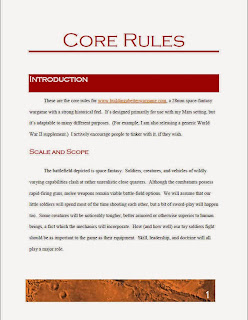 |
| Click on me for the rules. |
Over Christmas break, I revised my core rules into a PDF. Let's take a moment to look at the game, and what it's about.
What's Different about This Game?
My game is a platoon-level space fantasy game. It has two major strengths:
- It can represent a variety of different sci-fi or space-fantasy troops.
- It models fire and movement and suppression in a (mostly) realistic way.
Armor, Monsters, and Vehicles
 |
| This Brute is Tough. |
- Armor: The model is covered in some sort of plating that absorbs or deflects projectiles.
- Toughness: The model is a bigger, tougher creature than normal.
- Vehicle Armor: The model is a vehicle, and has significant armored plating that's heavier than personal armor.
- Cover: The model is behind (or carries with it) terrain or a field that prevents its injury.
- Armor Piercing: Counters armor.
- Massive: Blows up big monsters.
- Anti-Tank: Shoots up vehicles.
- High Explosive: Counters the effect of cover.
 |
| These Colonists escort a Vehicle. |
The game's combat and damage are divided into several phases:
- Shooting: This represents long-ranged shooting. It might kill some enemy, but that's not its main purpose. The Shooting phase is when your models Suppress the enemy in preparation for an assault.
- Assault Fire: Your models have now closed with the enemy, and exchange fire at close range.
- Melee: Your models run up and hit the crap out of things with a chainsaw, bayonet, or pointy stick.
What about Vehicles?
As a platoon-level game, there's room for only a few vehicles on the table. They are a combination of awesome and fragile: with machine-guns aplenty and mostly invulnerable to infantry weapons in the Shooting Phase. But up close, in the Assault Fire or Melee phase, lucky rolls can hit them pretty reliably, meaning any such beast requires an escort of friendly infantry model.









No comments :
Post a Comment